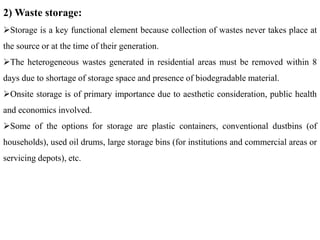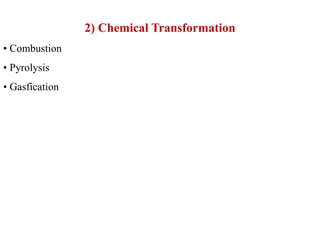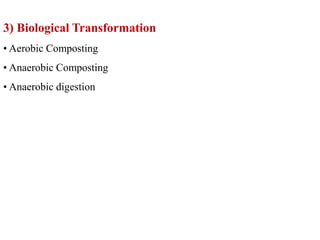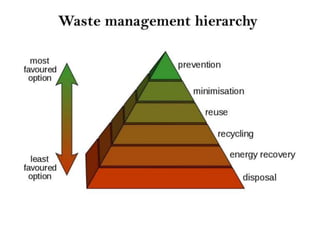Solid Waste Management
- 1. Functional Elements of Solid Waste
- 3. 1) Waste generation: Wastes are generated at the start of any process, and thereafter, at every stage as raw materials are converted into goods for consumption. The source of waste generation, determines quantity, composition and waste characteristics. For example, wastes are generated from households, commercial areas, industries, institutions, street cleaning and other municipal services. The most important aspect of this part of the SWM system is the identification of waste.
- 5. 2) Waste storage: Storage is a key functional element because collection of wastes never takes place at the source or at the time of their generation. The heterogeneous wastes generated in residential areas must be removed within 8 days due to shortage of storage space and presence of biodegradable material. Onsite storage is of primary importance due to aesthetic consideration, public health and economics involved. Some of the options for storage are plastic containers, conventional dustbins (of households), used oil drums, large storage bins (for institutions and commercial areas or servicing depots), etc.
- 8. 3) Waste collection: This includes gathering of wastes and hauling them to the location, where the collection vehicle is emptied, which may be a transfer station (i.e., intermediate station where wastes from smaller vehicles are transferred to larger ones and also segregated), a processing plant or a disposal site. Collection depends on the number of containers, frequency of collection, types of collection services and routes.
- 10. 4) Transfer and transport: This functional element involves: The transfer of wastes from smaller collection vehicles, where necessary to overcome the problem of narrow access lanes, to larger ones at transfer stations; The subsequent transport of the wastes, usually over long distances, to disposal sites. The factors that contribute to the designing of a transfer station include the type of transfer operation, capacity, equipment, accessories and environmental requirements.
- 14. 5) Processing: Processing is required to alter the physical and chemical characteristics of wastes for energy and resource recovery and recycling. The important processing techniques include compaction, thermal volume reduction, manual separation of waste components, incineration and composting.
- 15. 6) Recovery and recycling: This includes various techniques, equipment and facilities used to improve both the efficiency of disposal system and recovery of usable material and energy. Recovery involves the separation of valuable resources from the mixed solid wastes, delivered at transfer stations or processing plants. It also involves size reduction and density separation by air classifier, magnetic device for iron and screens for glass. The selection of any recovery process is a function of economics, i.e., costs of separation versus the recovered-material products. Certain recovered materials like glass, plastics, paper, etc., can be recycled as they have economic value.
- 16. 7) Waste disposal: Disposal is the ultimate fate of all solid wastes, be they residential wastes, semi-solid wastes from municipal and industrial treatment plants, incinerator residues, composts or other substances that have no further use to the society. Thus, land use planning becomes a primary determinant in the selection, design and operation of landfill operations. A modern sanitary landfill is a method of disposing solid waste without creating a nuisance and hazard to public health. Generally, engineering principles are followed to confine the wastes to the smallest possible area, reduce them to the lowest particle volume by compaction at the site and cover them after each day’s operation to reduce exposure to vermin. One of the most important functional elements of SWM, therefore, relates to the final use of the reclaimed land.
- 17. Transformation of solid waste Solid waste can be transformed by 1) Physical 2) Chemical 3) Biological means 1) Physical Transformation • Component separation • Mechanical volume reduction • Mechanical size reduction
- 19. 2) Chemical Transformation • Combustion • Pyrolysis • Gasfication
- 20. Chemical transformation or Combustion Organic matter + excess air N2 + Co2 + H2O + O2 + ash + heat
- 21. 3) Biological Transformation • Aerobic Composting • Anaerobic Composting • Anaerobic digestion
- 23. Aerobic Composting Organic matter + O2 + nutrients new cells + resistant organic matter + Co2 + H2O+ NH3 (Ammonia) + SO2 (Sulfur dioxide )+ heat Anaerobic Digestion Organic matter + H2O + nutrients new cells + resistant organic matter + Co2 + CH4 (Methane) + NH3 (Ammonia) + H2S (Hydrogen sulfide) + heat
- 25. 7 R's in solid waste management 1)Rethink 2)Refuse 3)Reduce 4) Repurpose 5) Reuse 6)Recycle 7) ROT
- 26. 1) Rethink Every time, you go for shopping to buy new clothes, or gadgets, think do you really need them? Consider going for a second-hand product. This way you will save resources and things from the trash pile. Instead of buying things from a popular international brand, go for local products. This way, you will help to shorten the supply chain, which decreases transportation energy, use of packaging, and at the same time you support the small entrepreneurs. 2) Refuse Refuse is the second element of 7R’s of hierarchy. It can effectively help to minimize waste. Well, refusing waste can take some practice; keep refusing to buy wasteful and non- recyclable products. Making smarter purchasing decisions and setting some standards will make it easier to refuse waste in the first place.
- 27. 3) Reduce Try to reduce the use of harmful, wasteful, and non-recyclable products. When you reduce dependency on these kinds of products, it leads to less waste material ending up in a landfill. Always use the minimum amount required to avoid unnecessary waste. When you reduce the amount of a consumable that you use will in turn reduce the amount of packaging that you are throwing away. Not all packaging is recyclable, so you need to think smartly. 4) Repurpose Finding another use for an item is one way of not needing to dispose that item and have it end in a landfill. There are some products that cannot be refused, reduced, or reused, you can try repurposing them. It needs some creativity, but the possibilities are endless. You can use old newspapers and other papers for arts and crafts, glass jars for holding food or planting new seeds, coffee mug for holding pens.
- 28. 5) Reuse In today’s market, single-use plastics have introduced a throw-away culture; it has normalized the consumer behavior of using materials once and then throwing them away. Today, the amount of plastics we consume is unimaginable. Also, the plastic crisis has become one of the major environmental challenges. Instead of buying any items, reuse things that you already have. You can start by replacing all of the single-use eating utensils, water bottles, Styrofoam cups, and paper plates with compostable or reusable alternatives. 6) Recycle Even if you dispose off your waste correctly, you never know where it will end up, so recycle where you can, even before generating the waste. In comparison to making a new plastic product, recycling uses less water, fossil fuel, and resource extraction. Keep in mind, plastic can only be down-cycled.
- 30. 7) Rot Take advantage of the natural decomposition process of nature to manage organic resources like food, tree limbs, scraps, etc. When such materials decompose in a controlled environment they convert into compost, a quality soil amendment that can improve gardens and the quality of the soil. Compost is called black gold as it helps plants retain moisture and gives them beneficial nutrients
Editor's Notes
- Pyrolysis: Heating of organic material in absence of oxygen. Decomposition braught about by high temperature. Gasification: Converts organic materials at 700 deg. Cel. without combustion with controlled amount of oxygen.





























